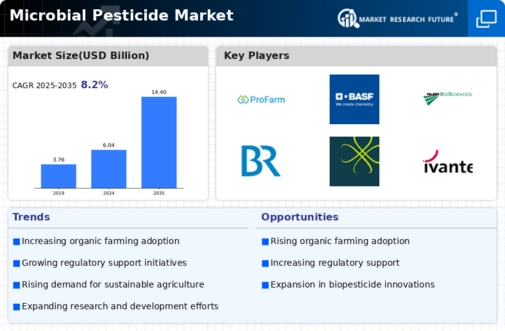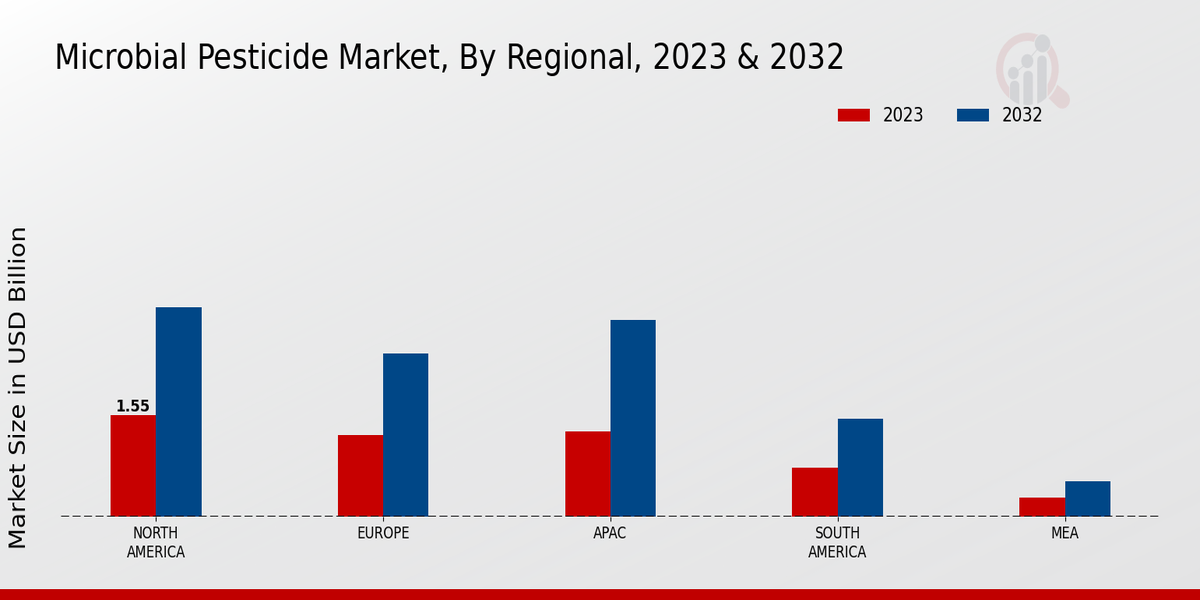Market Growth Projections
The Global Microbial Pesticide Market Industry is poised for substantial growth, with projections indicating a market value of 6.04 USD Billion in 2024 and an anticipated increase to 14.4 USD Billion by 2035. This growth trajectory suggests a compound annual growth rate (CAGR) of 8.23% from 2025 to 2035. Such figures underscore the increasing adoption of microbial pesticides as farmers and agricultural stakeholders recognize their advantages over traditional chemical pesticides. The market dynamics reflect a broader trend towards sustainable agricultural practices, driven by both consumer demand and regulatory support for environmentally friendly pest management solutions.
Rising Demand for Organic Farming
The increasing consumer preference for organic produce drives the Global Microbial Pesticide Market Industry. As more farmers transition to organic farming practices, the demand for environmentally friendly pest control solutions rises. Microbial pesticides, which are derived from natural organisms, align with the principles of organic farming. This shift is evident as the market is projected to reach 6.04 USD Billion in 2024, reflecting a growing inclination towards sustainable agricultural practices. The adoption of microbial pesticides not only supports organic farming but also enhances soil health and biodiversity, which are critical for long-term agricultural sustainability.
Regulatory Support for Biopesticides
Government regulations increasingly favor the use of biopesticides, including microbial pesticides, which bolsters the Global Microbial Pesticide Market Industry. Regulatory bodies are streamlining the approval processes for these products, recognizing their potential to reduce chemical pesticide usage and mitigate environmental impacts. For instance, the Environmental Protection Agency in various countries has established guidelines that promote the registration of microbial pesticides. This regulatory support is likely to enhance market growth, as it encourages manufacturers to invest in research and development of innovative microbial solutions. As a result, the market is expected to grow significantly, with a projected CAGR of 8.23% from 2025 to 2035.
Growing Awareness of Environmental Sustainability
The heightened awareness of environmental sustainability among consumers and farmers is propelling the Global Microbial Pesticide Market Industry. As concerns about chemical pesticide residues and their impact on ecosystems grow, there is a noticeable shift towards safer alternatives. Microbial pesticides offer a viable solution, as they are less harmful to beneficial insects and the environment. This trend is reflected in the increasing sales of microbial products, as farmers seek to adopt practices that align with sustainable agriculture. The market's expansion is indicative of this shift, with projections suggesting a robust growth trajectory as more stakeholders recognize the benefits of microbial solutions.
Technological Advancements in Microbial Pesticides
Innovations in biotechnology are transforming the Global Microbial Pesticide Market Industry. Advances in genetic engineering and formulation technologies have led to the development of more effective microbial pesticides that target specific pests while minimizing harm to non-target organisms. For example, the introduction of genetically modified strains of beneficial microbes has shown promise in enhancing pest control efficacy. These technological advancements not only improve product performance but also expand the range of applications for microbial pesticides in various crops. As the market evolves, these innovations are expected to drive growth and increase the market's value, potentially reaching 14.4 USD Billion by 2035.












